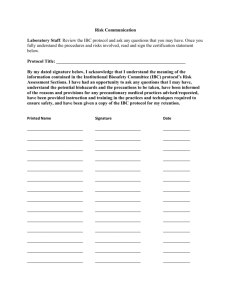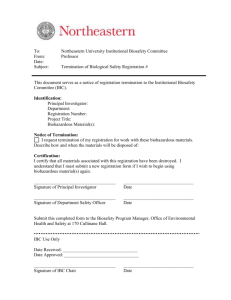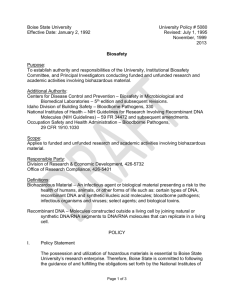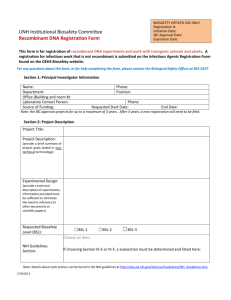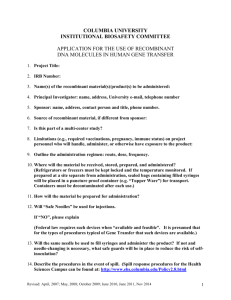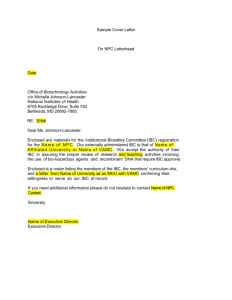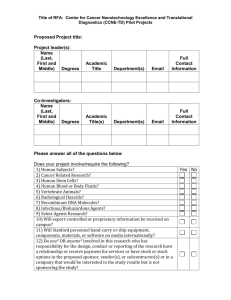IBC Policy - Texas Woman`s University
advertisement
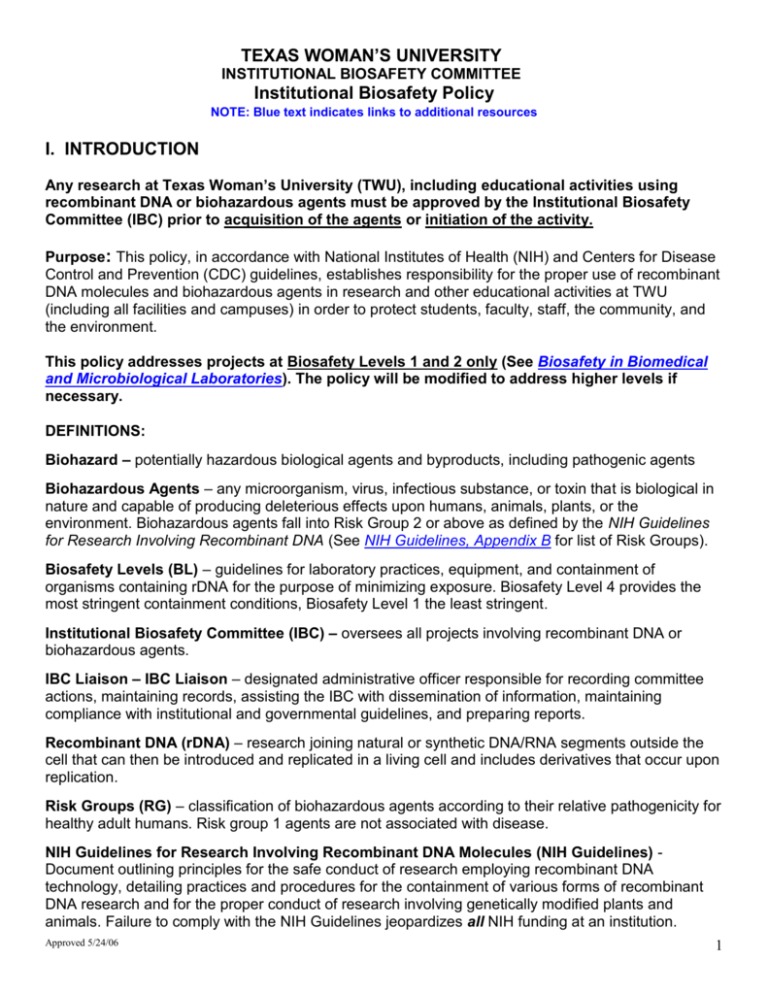
TEXAS WOMAN’S UNIVERSITY INSTITUTIONAL BIOSAFETY COMMITTEE Institutional Biosafety Policy NOTE: Blue text indicates links to additional resources I. INTRODUCTION Any research at Texas Woman’s University (TWU), including educational activities using recombinant DNA or biohazardous agents must be approved by the Institutional Biosafety Committee (IBC) prior to acquisition of the agents or initiation of the activity. Purpose: This policy, in accordance with National Institutes of Health (NIH) and Centers for Disease Control and Prevention (CDC) guidelines, establishes responsibility for the proper use of recombinant DNA molecules and biohazardous agents in research and other educational activities at TWU (including all facilities and campuses) in order to protect students, faculty, staff, the community, and the environment. This policy addresses projects at Biosafety Levels 1 and 2 only (See Biosafety in Biomedical and Microbiological Laboratories). The policy will be modified to address higher levels if necessary. DEFINITIONS: Biohazard – potentially hazardous biological agents and byproducts, including pathogenic agents Biohazardous Agents – any microorganism, virus, infectious substance, or toxin that is biological in nature and capable of producing deleterious effects upon humans, animals, plants, or the environment. Biohazardous agents fall into Risk Group 2 or above as defined by the NIH Guidelines for Research Involving Recombinant DNA (See NIH Guidelines, Appendix B for list of Risk Groups). Biosafety Levels (BL) – guidelines for laboratory practices, equipment, and containment of organisms containing rDNA for the purpose of minimizing exposure. Biosafety Level 4 provides the most stringent containment conditions, Biosafety Level 1 the least stringent. Institutional Biosafety Committee (IBC) – oversees all projects involving recombinant DNA or biohazardous agents. IBC Liaison – IBC Liaison – designated administrative officer responsible for recording committee actions, maintaining records, assisting the IBC with dissemination of information, maintaining compliance with institutional and governmental guidelines, and preparing reports. Recombinant DNA (rDNA) – research joining natural or synthetic DNA/RNA segments outside the cell that can then be introduced and replicated in a living cell and includes derivatives that occur upon replication. Risk Groups (RG) – classification of biohazardous agents according to their relative pathogenicity for healthy adult humans. Risk group 1 agents are not associated with disease. NIH Guidelines for Research Involving Recombinant DNA Molecules (NIH Guidelines) Document outlining principles for the safe conduct of research employing recombinant DNA technology, detailing practices and procedures for the containment of various forms of recombinant DNA research and for the proper conduct of research involving genetically modified plants and animals. Failure to comply with the NIH Guidelines jeopardizes all NIH funding at an institution. Approved 5/24/06 1 Principal Investigator (PI) – any TWU faculty member or staff member conducting research or other educational activities involving recombinant DNA molecules or biohazardous agents utilizing TWU facilities. Significant Event – any event which requires emergency medical intervention or is considered a major violation of NIH guidelines. II. GENERAL REQUIREMENTS AND PROCEDURES FOR RESEARCH WITH RECOMBINANT DNA AND BIOHAZARDOUS AGENTS Any research conducted with recombinant DNA or biohazardous agents, regardless of the source of funding or source of recombinant material, must be conducted in accordance with institutional requirements and federal guidelines. TWU adheres to NIH Guidelines and appropriate TWU safety standards, as issued. Research on recombinant DNA or biohazardous agents should also be conducted in accordance with CDC/NIH biosafety guidelines (Biosafety in Microbiological and Biomedical Laboratories), as appropriate. Experiments involving animals or plants may require compliance with additional regulations and approval by the Office of Agricultural Biotechnology, U. S. Department of Agriculture, the Texas Department of Agriculture, the NIH Office of Laboratory Animal Welfare or the TWU IACUC. In addition, research should comply with all institutional policies. It is essential that potentially biohazardous/recombinant DNA research be conducted in accordance with the intent, as well as specific requirements and guidelines. Because research is dynamic, it is not possible to anticipate every situation. The conscientious effort and good judgment of personnel are essential for protection of health and the environment during research. Primary responsibility for compliance with institutional and governmental requirements and for safe and proper experimentation resides with the PI. The IBC and chair are appointed by the Provost to review and approve research with recombinant DNA or potentially biohazardous agents on behalf of TWU. III. REGISTRATION, REVIEW, AND APPROVAL OF RESEARCH WITH RECOMBINANT DNA AND BIOHAZARDOUS AGENTS All laboratories containing recombinant DNA and/or biohazardous agents at TWU must be registered annually with the IBC by October 1. This includes, but is not limited to recombinant products, DNA probes, vector systems, related material received from outside sources, and all agents listed in Risk Group 2 or above. All proposals for biohazardous/recombinant DNA research, unless specifically exempted by the NIH Guidelines, Appendix C, must also be reviewed and approved by the IBC prior to initiating work. Review by the IBC includes evaluation for compliance with the NIH Guidelines; assessment of the containment levels required by the guidelines; assessment of the facilities, procedures, and practices; consideration of the training and expertise of research personnel; and verification of training required of all research personnel. A. Registration of Exempt Research with Recombinant DNA and Biohazardous Agents All research with recombinant DNA and biohazardous agents conducted at TWU must be registered each fall with the IBC using the Recombinant DNA and Biohazardous Agent Research Registration Form. The registration form must be signed by the PI and Department Chair before submission to the Office of Research and Sponsored Programs (ORSP). Upon completion of the registration form, researchers may be required to complete the Recombinant DNA and Biohazardous Agent Research Application Form for projects that are not exempted from IBC review. Changes in the scope of Approved 5/24/06 2 projects, termination of projects, or initiation of new projects require immediate update of the registration form and may require a formal application. NIH Exemptions from IBC review are listed in Appendix C along with their exceptions. Please refer carefully to both the exemptions and their exceptions before registering. B. Research and Related Activities Requiring IBC Review and Approval All other research (non-exempt), regardless of the source of funding, conducted at TWU involving recombinant DNA (including recombinant DNA used as probes or obtained from another laboratory) and/or biohazardous agents (RG2 and above) must be registered, reviewed, and approved by the IBC. The NIH Guidelines, Appendix B lists the most commonly encountered infectious agents by risk group. The PI is responsible for reviewing the NIH Guidelines and specifying in the IBC application the appropriate category for the proposed research or educational activity. Such classification is subject to IBC approval. New Investigation – All new projects involving recombinant DNA and biohazardous agents should be identified as such by the PI, acknowledged by the appropriate department administrator, and reviewed by the IBC prior to submission to the sponsor or initiation of the project. The ORSP will not approve funding proposals involving rDNA or biohazardous agents without required IBC approval. Project Modifications –IBC review and approval is required if the nature or content of research changes significantly or if recombinant DNA, either cloned or received from an outside source, is involved. Modifications must be reviewed and approved before work proceeds. Testing, Evaluation and/or Release – It is expected that all research at TWU will be conducted in a laboratory setting (inside a lab, growth chamber, containment, or cage). Project Completion/Termination – The PI will notify the IBC in writing of the completion or termination of a project. C. Submitting Applications for IBC Review The Recombinant DNA and Biohazardous Agent Research Application Form must include complete and adequate information and protocols. Documents for recombinant DNA/biohazardous agents review by the IBC should be signed by the PI and Department Chair before submission to the ORSP. D. Yearly review of projects All ongoing projects previously approved by the IBC must be updated annually on the anniversary of the original IBC approval date by submitting the Recombinant DNA and Biohazardous Agent Research Continuation Form. In addition, all PIs will complete the annual registration form due on October 1. IV. RESPONSIBILITIES OF PRINCIPAL INVESTIGATORS The PI, on behalf of TWU, is responsible for full compliance with the CDC/NIH guidelines and appropriate USDA regulations in conducting any research with recombinant DNA or potentially biohazardous agents. A. General Responsibilities of the PI: 1. Be aware of safety requirements for recombinant DNA and biohazardous agents and ensure that TWU required standards and procedures are followed. Approved 5/24/06 3 2. Assure that all work involving recombinant DNA and biohazardous agents is registered with the IBC. 3. Assure that necessary safeguards and procedures are maintained in the work place. 4. Follow the NIH Guidelines. 5. Be thoroughly familiar with NIH Guidelines and follow appropriate CDC/NIH biosafety guidelines when conducting research with recombinant DNA and/or biohazardous agents. 6. Make the initial determination of the required levels of physical or biological containment in accordance with the NIH/CDC guidelines. 7. Select appropriate microbiological practices and laboratory techniques to be used in the research as defined in the NIH Guidelines: a. Appendix G - Physical Containment Requirements for Standard Laboratory Experiments b. Appendix K - Physical Containment for Large Scale (>10 liters) Uses of Organisms Containing Recombinant Molecules c. Appendix P - Physical and Biological Containment for Recombinant DNA Research Involving Plants 8. Assure that all review and approval requirements are fulfilled prior to initiating any new or modified research procedures: a. Comply with shipping requirements for recombinant DNA molecules. b. Submit the initial research protocol if required by NIH Guidelines or institutional requirements. c. Notify the IBC of any significant changes in experimental protocol or location of research. B. Responsibilities of the PI prior to initiating research 1. Assure that labs and work places are identified with appropriate warning signs and that personnel are properly trained and informed regarding biohazards. 2. Provide laboratory members (including students) with copies of the protocols that describe the potential biohazards and the precautions to be taken. 3. Assure that laboratory members (including students) are trained in safe work practices, techniques, and procedures for dealing with accidental spills and personnel exposure. 4. Inform laboratory members of the reasons and provisions for any recommended precautionary medical practices such as vaccinations or serum collection. 5. Post emergency procedures for handling conditions such as spills and personnel exposure. C. Responsibilities of the PI during the research 1. Supervise laboratory members to assure that the required safety practices and techniques are employed and that appropriate containment procedures are followed. 2. Investigate and provide a written report within 30 days to the IBC and the NIH Office of Recombinant DNA Activities (ORDA) regarding any significant event, violation of the NIH Guidelines, and all significant research-related accidents and illnesses including corrective actions. Reports to NIH/OBA shall be sent to the Office of Biotechnology Activities, National Institutes of Health, 6705 Rockledge Drive, Suite 750, MSC 7985, Bethesda, MD 20892-7985 (20817 for non-USPS mail), 301-496-9838, 301-496-9839 (fax) 3. Correct work errors and conditions that may result in the release of recombinant DNA materials. 4. Assure the integrity of physical containment (e.g., biological safety cabinets) and the biological containment (e.g., purity, genotypic, and phenotypic characteristics). 5. Adhere to IBC-approved safety procedures and TWU safety standards (LINK) for handling accidental spills and personnel contamination. Approved 5/24/06 4 NOTE: Any suspected violation of this policy shall be reported to the Director of the TWU ORSP and/or the IBC. All such reports will be referred to the Institutional Biosafety Committee for review; and, if warranted, an investigation will be conducted to determine whether corrective action is needed. A PI who willfully or negligently violates federal, state, or TWU policies and standards governing the use of biohazardous agents or recombinant DNA molecules may have his/her IBC approval suspended by the IBC pending further investigation and final action. In the event the IBC’s final action includes revocation of IBC approval, the IBC is required to notify any sponsoring agency of such action. Upon confirming a violation, the IBC may recommend corrective action, up to and including, suspension of all research activity until the violation is corrected. Any rDNA or biohazardous agent requiring IBC approval may not be transferred to other laboratories or researchers (within the institution or elsewhere) without written notification of approval of the transfer by the governing IBC. V. RESPONSIBILITIES OF INSTITUTIONAL BIOSAFETY COMMITTEE The IBC reviews and monitors all research projects, including educational activities, involving the use of recombinant DNA molecules and biohazardous agents. A. IBC Responsibilities: 1. Review recombinant DNA/biohazardous agents research projects including: a. Assessing the containment levels required by the NIH Guidelines for proposed research. b. Assessing facilities, procedures, practices, training, and expertise of personnel involved in research or other educational activities. 2. Notify PI of results of IBC review and approval. 3. Ensure that the PI has sufficient training in the proper use, handling, and disposal of all biohazardous agents and recombinant DNA 4. Adopt emergency plans covering accidental spills and personnel contamination resulting from recombinant DNA/biohazardous agent research or other educational activities as specified in the Laboratory Safety Monograph (LINK) and TWU Safety Standards (LINK). 5. Review recombinant DNA molecule and biohazardous agent research or other educational activities conducted at TWU to ensure compliance with Biosafety in Microbiological and Biomedical Laboratories, the NIH Guidelines, and any guidelines adopted by the IBC. 6. Report any significant research or education-related illnesses or accidents that may be hazardous to state and local public health departments. 7. Report any significant problems with or violations of the NIH Guidelines and any significant research/education-related accidents or illnesses involving recombinant DNA molecules to the TWU ORSP and the NIH Office of Biotechnology Activities within 30 days, unless a report has already been filed by the PI. 8. File an annual report with the NIH Office of Biotechnology Activities. 9. Periodically review these policies and procedures and notify the TWU ORSP of any recommended revisions to the policy. 10. Investigate and take appropriate action regarding reports of PI violations of federal, state, or TWU regulation, policies, or standards. Approved 5/24/06 5 11. The IBC Chair is responsible for ensuring that IBC members are appropriately trained. The IBC may not authorize initiation of experiments which are not explicitly covered by the NIH Guidelines until NIH establishes the containment requirements. B. IBC Membership and Procedures: 1. The term for each member shall be 3 years with staggered terms, and members shall be eligible for re-appointment. 2. The Institutional Biosafety Committee (IBC) shall consist of at least 5 voting members. 3. At least two individuals with no affiliation with TWU shall be appointed to represent the local community. 4. At least one member will represent the technical staff. 5. Members shall be selected so that they collectively have the expertise and experience to review the types of recombinant DNA molecules and biohazardous agent research and educational activities conducted at TWU, to assess the safety of such research, and to identify any potential risk to public health or the environment. 6. The IBC may use non-voting ad hoc consultants as necessary to provide special expertise for review of specific proposed research or educational projects. 7. No member of the IBC may be involved (except to provide information requested by the IBC) in the review or approval of a project in which he/she has been or expects to be engaged or has a direct financial interest. 8. The IBC shall meet as needed, but at least once per year. All meetings are open to the public although discussions of proprietary information may be held in closed sessions. Minutes are available on request. VI. RESPONSIBILITIES OF THE INSTITUTION TWU is responsible for ensuring that research involving rDNA and biohazardous agents is conducted in full conformity with the provisions of the NIH Guidelines. A. Institutional Responsibilities: 1. Establish and implement policies that provide for the proper use of recombinant DNA and biohazardous agents in research. 2. Establish an IBC that meets the requirements set forth in the NIH Guidelines. 3. Ensure appropriate training for IBC members, PIs, and laboratory members regarding laboratory safety and implementation of the NIH Guidelines. 4. Report violations of the NIH Guidelines or any significant research-related accidents and illnesses to NIH/OBA within 30 days, unless a report has already been filed by the PI or IBC. 5. Assist and ensure compliance with the NIH Guidelines by PIs. VII. INSTITUTIONAL BIOSAFETY COMMITTEE RECORDKEEPING All IBC records are maintained in the TWU ORSP. Minutes of the IBC meetings and related documents are available upon request when consistent with protection of privacy and proprietary interests. The Institutional Biosafety Committee shall maintain the following records: 1. registration, application, or renewal forms for research projects or educational activities. 2. minutes of each IBC meeting, including deliberations and actions on new projects, renewal projects, modifications, or terminations of projects previously approved. Approved 5/24/06 6 3. reports and correspondence with the NIH. VIII. RESPONSIBILITIES OF IBC LIAISON The IBC Liaison is the designated administrative officer who assists the IBC in its role. The IBC Liaison is responsible for recording committee actions, maintaining all IBC records, assisting the IBC with dissemination of information, maintaining compliance with institutional and governmental guidelines, and preparing reports. IBC Liaison Responsibilities: 1. Assist the IBC with informing department administrators, PIs, and others of biosafety requirements. 2. Assist the IBC with maintaining compliance with institutional and governmental guidelines and regulations. 3. Assist the IBC chair with preparation of required reports. 4. Record committee actions Approved 5/24/06 7
